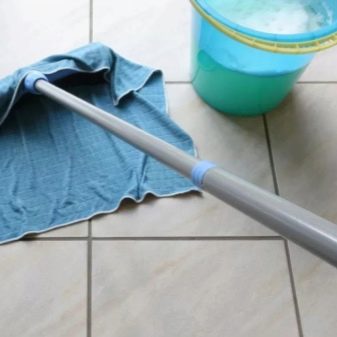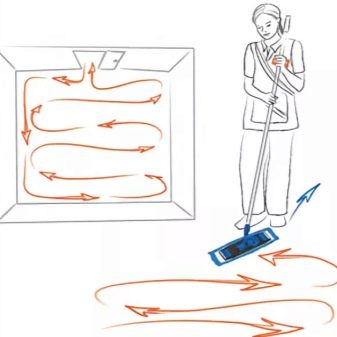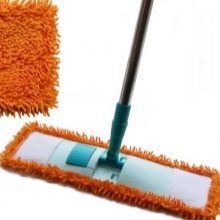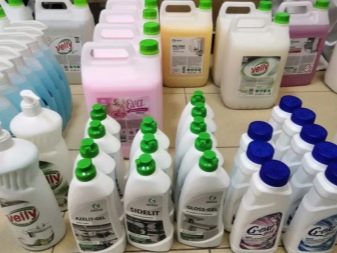How to do wet cleaning correctly?

And in a private house, and in an apartment, and even at the workplace, it is very important to wet cleaning the laminate and other surfaces. For this purpose, floor polishing robots and other floor machines are sometimes used. But first you need to figure out what kind of procedure it is, and how exactly to do daily cleaning in the apartment.
What it is?
The popular expression - "cleanliness is the guarantee of health" - does not lose its relevance from frequent repetition. Good hygienic conditions are just as important as proper nutrition, daily routine, or general peace of mind. However, maintaining order anyhow is not the case either. Wet cleaning isn't just about removing dust and dirt with water and a wet cloth. It also humidifies the air in the rooms.
It has long been well known that it is the dryness of the air that is very harmful to health, while it is very common in city apartments. The dust accumulates very actively, the ways of its penetration are varied. Therefore, if wet cleaning is not carried out regularly, extraordinary measures are soon required to restore elementary order. And dust is not harmless villi. It contains a number of highly toxic substances and aggressive living organisms.


You need to understand that this type of cleaning differs from dry not only by the use of water itself, and there are important rules here:
-
clean water should be used whenever possible;
-
it is better to abstain altogether from the use of synthetic detergents in the rooms of allergy sufferers;
-
dry and wet cleaning is desirable to alternate for more effective maintenance of order in the house;
-
surfaces should be cleaned from top to bottom and from windows (or far corners) to the entrances;
-
if possible, you should use not home-made, but factory-made equipment and equipment.


Frequency
How often you need to use wet cleaning depends on the specific location. It is generally accepted that even in the most favorable conditions, it should be carried out at least once every two days. But it should be daily if:
-
an apartment or house is located in an industrial area;
-
windows open onto a busy road;
-
the ecological state of the area is unfavorable;
-
there are children or pets in the house (sometimes in these cases you even have to clean up twice a day).


But these factors are not the only thing to consider. So, in the summer months you will have to clean up more often. It is then that dust and dirt rush through open windows especially strongly into all rooms.
It should be noted that wet cleaning can sometimes be carried out only once a week. For example, if no more than two people live in the house, there are no children or pets; but if a "locking" cyclone or anticyclone comes, due to which smog appears, you will have to wash the house more often.

What is required?
Inventory
The minimum kit for wet cleaning includes:
-
buckets;
-
basins;
-
clean water;
-
rags for floors;
-
soft cloth rags;
-
sponges with a hard surface;
-
brushes for upholstered furniture;
-
melamine-based sponges for tidying up window sills, the same furniture, walls;
-
scoops and brooms (they are no less important today than advanced technology);
-
vacuum cleaner with a set of nozzles and hoses;
-
rubber gloves for hands;
-
mop - again, with replaceable nozzles;
-
a reliable step-ladder (you can replace it with tables, stools or chairs as a last resort).



Everything that is required is prepared in advance. And they do not just cook, but lay out and arrange in the most convenient places. It is not always obvious what these places are; however, usually in six months or a year, the necessary skill is developed. Many people think about buying a floor polishing robot, believing that this machine will greatly facilitate their household chores.
However, the problem is that modern technology of this kind is effective only on smooth, even surfaces; devices that can almost move furniture and move through different levels of the room, so far remain on the pages of science fiction novels.

Household chemicals
With all the power of ordinary clean water, it is almost impossible to do without the use of detergents. And even where they are not formally required, it can save a lot of time and effort. There is no point in highlighting specific brands and types of detergent compositions, because everyone has their own preferences, and functionality should come first. For cleaning the floor, use concentrated solutions. They usually include:
-
disinfectant;
-
reagents that eliminate biological stains;
-
flavors.
Necessarily needed and means with which to clean mirrors and glass. They wash away streaks that may remain with conventional wet cleaning. Experts advise using sprays, although special foams have their supporters.


You can put things in order on upholstered furniture using mixtures designed for cleaning textiles from universal dirt.
In bathrooms, toilets and combined toilets, two types of products are needed. Some preparations remove rust, calcium deposits and water marks from ceramics and metal. Others are responsible for deep disinfection and powerful cleaning of pipes, toilets and sinks (this is also, in fact, a kind of wet cleaning).
You can put things in order in the kitchen with the help of compounds that effectively remove fat and traces of burnt food. In order to ensure a guaranteed result and not harm the surfaces to be cleaned, you can resort to professional household chemicals. But you need to understand that it costs more than usual, and if used illiterately, it can still be dangerous.


Algorithm for conducting the house
The composition of wet cleaning includes:
-
dust removal daily;
-
air humidification;
-
weekly (at least) cleaning of the entire house.
This is the smallest set, without which even elementary order cannot be maintained. However, sometimes this is not enough.


To less often face the need to do a general cleaning, you need to strictly build on the correct wet cleaning system. It has been used by many millions of families and professional washers, so there is no reason to doubt its effectiveness.
- The first step is preparatory cleaning, which brushes dust off cabinets, ceiling lights and other items in the upper tier.
- Properly performed wet cleaning in any room involves moving from top to bottom. When the top is in order, you can move on to the middle level, for example, window sills and ordinary furniture. At the same time, they are courting decor and household appliances.
- Cleaning the floor with a vacuum cleaner, wiping the baseboards with a damp cloth and washing itself helps to complete the cleaning. When it is over, you should open the windows; in the summer this can be done even immediately in the process.
- The last thing to do is wipe mirrors and glossy surfaces. It is they who collect dust much more readily than other objects.
- Hallways and bathrooms are washed later than other rooms. In each room it is necessary to wash both lampshades (lampshades), and doors, and door frames. We must not forget about radiators and heaters, about the need for regular rinsing of rags.
- High-grade laminate flooring should be washed every 2-3 days. Lower product categories are optimized for cleaning no more than 1 time per week. Soft brushes and rags work well. However, harsh implements and aggressive cleaning agents are unacceptable. Whenever possible, clean water should be used or surfaces should be treated with steam cleaners.
- It is necessary to use only warm (40 to 50 degrees) water. The rags should be rinsed more often and the water should be changed as soon as it becomes cloudy.
- If the laminate or other coating is clogged with glue, grease, oil products, felt-tip pens, you will have to use special cleaning agents. Old stains are removed with acetone or white spirit. Such treatment should only touch dirty places and should not last longer than a few minutes.
- If there are animals in the house, you will have to clean the wool every day. To cope with it, brushes with stiff bristles help. You will have to move them abruptly. If the wool does not fall on a carpet or other fleecy surface, but on a smooth and even floor, it should be cleaned as usual. Cleaning of wool and hair from furniture, carpets, is done according to the manufacturer's instructions.



It should be understood that household chemicals can cause direct harm to health. When using it, you need to open windows (and leave them open until the end). It is useful to deal with unwashed dishes before cleaning. When cleaning ceramic tiles, pay maximum attention to the seams. In the hallways, shoe racks and shoes themselves, any shelves, rugs and thresholds must be cleaned.
Useful Tips
The exact cleaning procedure looks like this:
-
balconies;
-
the most distant living rooms;
-
other living rooms;
-
pantries or dressing rooms;
-
kitchens;
-
corridors;
-
bathrooms.



You should move confidently, but not too quickly or deliberately. It is necessary to think in advance what containers with water, household chemicals where to put. It is useful to use special impregnations for upholstered furniture. The protective film they form will block the appearance of stains and the absorption of foreign odors. You cannot wash mirrors and glass with compounds containing alcohol. Divorces may remain.
In any case, during wet cleaning, it is necessary to disinfect:
-
door and window handles;
-
keyboards and mice;
-
remotes, telephones, other gadgets and headphones.

There are also such recommendations:
-
use rags based on cotton or microfiber;
-
drip a small amount of essential oil into a bucket of water;
-
add antistatic agents when processing furniture;
-
spray radiators and heated towel rails with spray guns (then all the dirt will quickly drain into the substituted container);
-
dry carpets thoroughly;
-
if possible, avoid washing linoleum, laminate and wood with hot water;
-
be sure to remove the cobweb.










